Sydney na Piaskach – Sydney on Piaski
Eighty youth celebrated World Youth Day at the Schoenstatt Shrine in Bydgoszcz, Poland
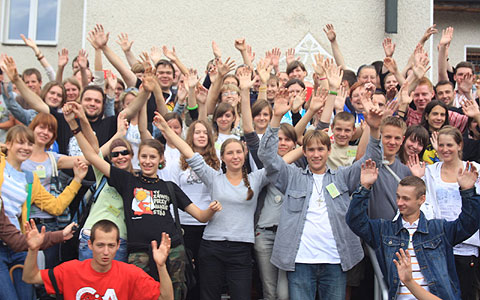 |
Ochenta jóvenes celebraron la JMJ en el Santuario de Schoenstatt de Bydgoszcz, Polonia Eighty youth celebrated World Youth Day at the Schoenstatt Shrine in Bydgoszcz, Poland Achtzig Jugendliche begingen den WJT beim Schönstatt-Heiligtum in Bydgoszcz, Polen |
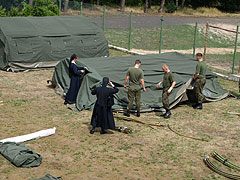 |
|
Armando las carpas Setting up the tents Aufbau der Zelte |
|
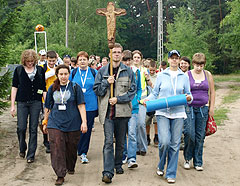 |
|
Peregrinación Pilgrimage Pilgerweg |
|
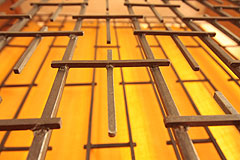 |
|
¿Qué es el sentido de las rejas? What does the cloister grill mean? Was bedeuten die Gitter? |
|
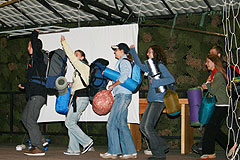 |
|
Recordando la JMJ en Colonia Remembering WYD in Cologne Erinnerungen an den WJT in Köln |
|
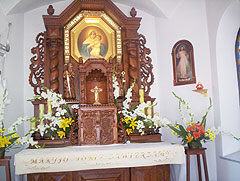 |
|
En el Santuario In the Shrine Im Heiligtum Fotos: Wiland © 2008 |
|
POLAND, Wioletta Wiland. From July 17 – 20, 2008, 80 young people from the Bydgoszczy, Poland, area, followed the invitation to celebrate World Youth Day at the Schoenstatt Shrine at Bydgoszcz-Piaski. "Sydney na Piaskach – Sydney in Piaski" was a joint iniative of the Schoenstatt Youth and the diocese. For many of the youth, a visit to a nearby Carmel was one of the highlights.
The young people lived in tents borrowed from the Polish Army. Fr. Wenancjusz Zmuda – responsible for the youth in the diocese and Sr. M. Elwira from Bydgoszcz gave spiritual input. The young people had a busy program filled with prayers, pilgrimages, smiles, songs, joy. "Have courage to live for love" – these words of John Paul II were remembered often.
Among many events during the meeting "Sydney in Piaski" on 17-20th of July 2008 there was one which was especially deep. It was the visit to the Carmelite Cloistered Sisters in Tryszczyn near Bydgoszcz. First the group celebrated Holy Mass for the new vocations to the priesthood and consecrated life. The main celebrant was the director of Bydgoszcz Diocesan Seminary, Fr. Wojciech Szukalski. After Holy Mass there was time for rest in the sisters’ garden and an opportunity for meeting.... through the cloister grill. Many questions were asked and many surprising answers found.
What does the cloister grill mean?
Frankly, I was absolutely not interested in this meeting. What important or interesting things could I possibly learn from a cloistered sister whose whole life is completely enclosed - in the house and garden with a high wall all around?
The visiting room was full of people. Everyone wanted to come and talk to sisters. From the very beginning they were friendly and joyful. We started to joke a little bit, looking for new vocations to the Carmelite Cloister from among us (men and women), but I think from the very beginning we were impressed by this place and the sisters.
We started with questions about vocations, about formation, about their style of life, about the daily order, about using "things" for example tv, radio, internet. We got to know that sisters stay their whole life in this place, praying for the world and they do all the work at home: cooking, cleaning, gardening, sewing etc. They also earn money by embroidering church stuff. They don’t watch tv, listen to the radio (except the Vatican News), but they know from priests and other people what’s going on in the modern world.
There were normal questions such as the menu at the sisters’ house (by the way, we noticed that from potatoes one can do many delicious meals).
But there were also very important questions - What is freedom? And what is the sense of these iron bars? At this moment the sisters asked, "And in your opinion where are the bars? On which side?"
The sisters said to us that feerdom means to absolutely trust in Divine Providence, who takes care for everything they need. They gave a beautifull testimony to this trust in everyday details. For example, a sister went to the superior and said they need to buy cauliflower, but she said they don’t need it although they insisted. Then suddenly a man came to their house and gave them cauliflower (so this what they needed the most).
The example is maybe very mundane, but it’s accurate for us – people from the world, who always care about many things for themselves and their families.
For the sisters, freedom also means this concrete place, where they can live so close to God all the time, not only praying in the chapel, but also in the house or in the garden working, or resting together.
And what is the sense of these iron bars? And on which side are they?
I answered this question. The bars are on our side because the world and "worldly things" do not always lead us to freedom, just the opposite – they can captivate us. And for each of us it can be a different thing, but always something which separates us from God, leads us away from Him
From this meeting I can’t stop thinking about these iron bars....
Our Father and Founder also thought that freedom is really important and said to the boys in 1912 "We have to have characters full of inner freedom. God doesn’t want any galley slaves. He wants to have free oarsmen." (Prefoundation Act 27.10.1912). His whole life he lived absolutely surrendered to God’s Providence and believed: " God is the Father, God is good and everything He does is good".
Who am I ? Am I really a free oarsman, who flows on the life river with the current led by God? Or am I the galley slave, who flows on the life river against the current and against God’s will? Who am I? Am I the oarsman who takes into his hands the oar of the life’s vocation given by a loving God and Father? Or am I the galley slave who tires to reach the aim – the professional career, the social position, the material status – not caring about God’s plan? How much do I trust Divine Providence? How bravely can I row into an unknown future or swim out into the deep waters of my vocation? Am I able to receive everything that God has planned for me?
I looked at the sisters, behind the bars. They didn’t notice me at all and I saw smiling, satisfied and happy women. They don’t lack for anything. (although humanly speaking they have nothing.) They are fulfilled (although humanly speaking they live enclosed) and they are for sure absolutely free.
And what is the sense of these iron bars, which separate the Carmelites from the rest of the world? These bars are the safety limits for the sisters which are put there - not for the sisters, but for the world – to not let it to come into this garden of Mary and not disturb this beautiful harmony between creation and the Creator....
These iron bars really have a meaning.... For me – a consecrated woman in the midst of the world – the iron bars have very special meaning....
Together with the young people of the whole world
Back at the Shrine, expectation grew. With joy, the young people listened to the words of Pope Benedict on Saturday evening at the ceremony in Sydney. On the last evening they remembered the World Youth Day in Cologne in 2005, and finally on Sunday night from 2 am till 5 am they were in Radwick in Sydney together with young people from all over the world who celebrated World Youth Day...